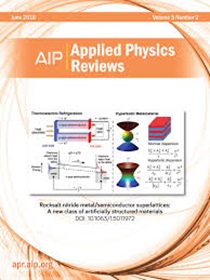Thermal transport property of boron nitride nanosheets
IF 11.9
1区 物理与天体物理
Q1 PHYSICS, APPLIED
引用次数: 0
Abstract
The rapid progress of high-performance microelectronic devices underscores the urgent necessity to develop materials possessing superior thermal conductivity for effectively dissipating heat in cutting-edge electronics. Boron nitride nanosheets (BNNSs) have garnered significant attention due to their exceptional thermal conductivity, combined with electrical insulation and low thermal expansion coefficient, offering a promising solution to heat-related challenges in electronic devices. While BNNSs share some common thermal behaviors with other two-dimensional (2D) materials, they also exhibit unique characteristics. For instance, BNNSs exhibit larger isotope disorders compared to graphene, yet their isotope enhancement in thermal conductivity is lower than that of their carbon counterpart. This review provides an overview of the thermal transport properties and mechanisms of BNNSs explored over the past decade, beginning with a brief introduction to the basic of thermal conductivity. It then delves into the thermal transport mechanisms in BNNSs, highlighting factors impacting the in-plane thermal conductivity of BNNSs, as well as the cross-plane thermal conductivity and the factors influencing it. Finally, the review discusses challenges associated with BNNS thermal conductivity measurement and outlines potential future research avenues.氮化硼纳米片的热传输特性
随着高性能微电子器件的快速发展,迫切需要开发具有优异导热性能的材料,以便为尖端电子器件有效散热。氮化硼纳米片(BNNSs)因其优异的导热性、电绝缘性和低热膨胀系数而备受关注,为解决电子设备中与热有关的难题提供了一种前景广阔的解决方案。虽然 BNNS 与其他二维(2D)材料具有一些共同的热行为,但它们也表现出独特的特性。例如,与石墨烯相比,BNNSs 表现出更大的同位素紊乱,但其热导率的同位素增强却低于碳材料。本综述概述了过去十年中探索的 BNNS 热传输特性和机制,首先简要介绍了热导率的基本原理。然后深入探讨 BNNS 的热传输机制,重点介绍影响 BNNS 面内热传导率的因素,以及跨面热传导率及其影响因素。最后,综述讨论了与 BNNS 热导率测量相关的挑战,并概述了未来可能的研究方向。
本文章由计算机程序翻译,如有差异,请以英文原文为准。
求助全文
约1分钟内获得全文
求助全文
来源期刊

Applied physics reviews
PHYSICS, APPLIED-
CiteScore
22.50
自引率
2.00%
发文量
113
审稿时长
2 months
期刊介绍:
Applied Physics Reviews (APR) is a journal featuring articles on critical topics in experimental or theoretical research in applied physics and applications of physics to other scientific and engineering branches. The publication includes two main types of articles:
Original Research: These articles report on high-quality, novel research studies that are of significant interest to the applied physics community.
Reviews: Review articles in APR can either be authoritative and comprehensive assessments of established areas of applied physics or short, timely reviews of recent advances in established fields or emerging areas of applied physics.
 求助内容:
求助内容: 应助结果提醒方式:
应助结果提醒方式:


